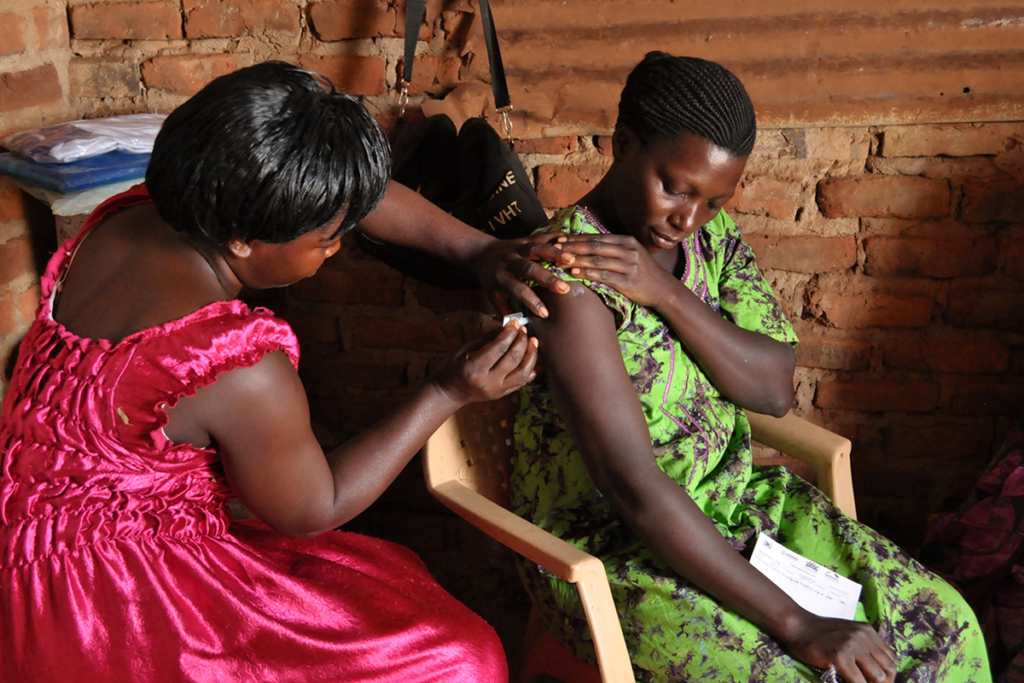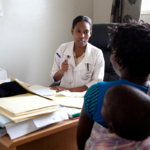This blog post was originally released on K4Health’s Medium publication, The Exchange. Reposted with permission.
It was a warm spring day in 2011, and eight of my colleagues were helping me celebrate the realization of a long-awaited policy change in Uganda by sipping tepid champagne out of kid-sized paper cups. A colleague asked me, amazed, “How did you guys pull this off? What’s your secret to changing national policy?” I offered up some words about patience, doggedness, and committed team work. My somewhat glib response is still true, but since then I’ve thought a lot about what it takes to get a policy changed.
As a Research Utilization (RU) specialist, I work to translate research evidence into policy and practice, scale up proven innovations, and make a positive impact. These aims are also hot topics in international development and public health at large. We want to know that our practices, programs, and policies are based on the best evidence, and that our time, effort, and money are well spent. An RU effort I worked on from 2006 to 2013 illustrated one successful example of using evidence to change policies and practices. I was part of a team that helped transform a promising approach in family planning to a standard practice that was recommended by the World Health Organization (WHO) and adopted in many parts of Africa.
The family planning approach is known as community-based access to injectables (CBA2I) — the practice of using trained community health workers to safely and effectively provide injectable contraceptives, such as Depo Provera, to women in the communities where they live.
The acceptance of CBA2I in Africa is an important leap forward in family planning because it addresses some major challenges in family planning: It allows women in remote areas to manage (discreetly) whether and when they want to have children, and it maximizes existing health care resources in the context of a global shortage of health care workers.
Measuring Success
I now look back in amazement on what was accomplished in those seven years:
- A WHO meeting of technical experts in 2009 concluded that CBA2I was safe, effective, and acceptable.
- A WHO statement in 2010 recommended the introduction, continuation, and expansion of CBA2I.
- Ten sub-Saharan African countries changed policies to allow the administration of injectables by lower-level health care workers.
- Fifty-five international and sub-Saharan African partners worked to expand CBA2I.
- We compiled 150 resources supporting CBA2I in a toolkit.
- Seventy million women of reproductive age gained the option of receiving injectable contraception from a community-based provider.
 By April 2013, ten African countries had changed their policies to allow CBA2I, and several other countries were introducing pilot studies or exploring the introduction of the practice.
By April 2013, ten African countries had changed their policies to allow CBA2I, and several other countries were introducing pilot studies or exploring the introduction of the practice.
The Recipe
The acceptance and expansion of CBA2I was dramatic and rewarding. But was it just a one-time case of fortunate circumstances? I don’t believe so. I think this success could be reproduced in similar endeavors — assuming they were able to include some key ingredients. Think of it as a recipe for the successful translation of research into policy and practice. My apologies in advance to those who can’t stomach strained metaphors.
Cooking Instructions
- Use a time-tested cookbook: Systematic use of research-based evidence and experience
- Use high-quality ingredients: The right people
- Use the appropriate utensils and cookware in a well-stocked kitchen: Alignment of innovation and environment
- Stir constantly: Continuous financial support
- Improvise if some of the ingredients are missing: Preparation and improvisation
Let me elaborate on the significance of each step.
Use a time-tested cookbook: Scale-up efforts should be based on research evidence and experience — the foundation of research utilization. Next, choose a proven pathway to guide your efforts for getting knowledge into policies and practice. Fortunately, we have many good frameworks, guides, and tools on the “how-to” of scale-up. In our case, we mixed models, concepts, and strategies drawing heavily on our own SCALE approach, WHO ExpandNet’s Nine Steps for Developing a Scaling-Up Strategy (PDF link), and Management Science for Health’s A Guide for Fostering Change to Scale Up Effective Health Services (PDF link). Here’s a cooking tip: It matters less which scale-up model you use… as long as you use one.
Use high quality ingredients: Hire the right people who can get the job done. In our case, the original resource team — a researcher, program manager, donor, utilization specialist, and several in-country advocates — provided an effective combination of perspectives, expertise, and networks and collaborated continuously for seven years (and continues to, to this day). The scale-up process benefited from our different skill sets and spheres of influence, but also from each member’s way of approaching and solving problems. As we shared views and perspectives, we built trust and developed a shared sense of purpose — qualities that are essential to high-performing teams. Each member of the original team also possessed a strong personal commitment to improving lives and a belief that CBA2I was an untapped way to provide access to family planning where it was needed most.
Use the appropriate utensils and cookware in a well-stocked kitchen: Make sure the innovation is aligned with the environment. Community-based access to injectables is a relatively simple innovation to add to a well-functioning community health program, so its “scalability” is high. This is especially true in sub-Saharan Africa, where injectables have been the most popular contraceptive method for nearly 20 years and the need for family planning services is high. The introduction of CBA2I also took place during a period when (1) global health trends favored activities that increased access to and choice of contraceptive methods in underserved areas, and (2) a critical shortage of doctors, nurses, and midwives allowed task shifting (or sharing) to gain traction.
Stir constantly: You will need a continuous stream of financial support. We were never in a position to assume that funding would be there to fuel our ever-evolving vision of scale-up. At times we had less than a year of support ahead of us. However, a very engaged donor responded to our promising results and cogent appeals with a consistent stream of revenue. Funding was always modest but just enough to focus on retaining dedicated person-power, implementing deliberate activities, and encouraging creativity and collaboration. The growing scale-up also forced us to find more sources of funding and to pivot around country ownership; financial needs were more fully met as more partners and programs emerged.
Improvise if some of the ingredients are missing: Be prepared for unexpected setbacks, and maintain a flexible mindset. While we executed proven RU strategies — such as cultivating local champions, communicating evidence in effective formats, and developing program guidance — unplanned activities sometimes made all the difference. For example, the momentum for a pilot in Zambia stopped suddenly when a local partner’s regional signatories refused to sign off on the project. We capitalized on a colleague’s willingness to deliver a short presentation for us when we learned that she happened to be near the partner’s regional office. As a result, the opposition parties changed their minds — allowing the rapid advance of practice and policy — simply because of chance and improvisation. Zambia is now the most recent African country to issue a national statement promoting the widespread scale up of the CBA2I practice.
The Secret Ingredient: Research Utilization
Though every ingredient and step plays a role in a successful recipe, some parts are more essential than others — consider the chicken in a chicken soup. Likewise, the first ingredient in our recipe — an investment in research utilization — should be the backbone of any scale-up endeavor. It’s notable that many governments and practitioners increasingly demand evidence-based solutions for development challenges, yet many development endeavors fail to include research utilization as a regular part of their research and scale-up efforts. This is surprising in the light of a growing recognition that evidence does not put itself into practice by its mere existence. Research and development stakeholders, including donors, must be routinely reminded to invest in strategies that bridge the gap between research and practice.
So, nowadays, when a colleague asks me how CBA2I was scaled up nationally and regionally, I mention the five key steps, and then I direct them to FHI 360’s research utilization website. The site describes a systematic approach that we have been using since 2001 to accelerate the transition from research to policy change, implementation, and scale-up. The late Dr. Ward Cates, President Emeritus of FHI 360, summed up the importance of research utilization when he said: “For us, it is not enough to move through the scientific process — to hypothesize, test, analyze data, and get knowledge published. RU answers the ‘So what?’ question about the research findings. RU translates research into usable knowledge and gets results into the field in an organized way.”
We’d like to hear your thoughts and questions about our list of key ingredients, including research utilization, so please write to us at: ResearchUtilization@fhi360.org.
Photo used with permission. Photo credit: Laura Wando, WellShare International Uganda, 2016




